翻译教学的描述途径
大学英语教学中的翻译教学
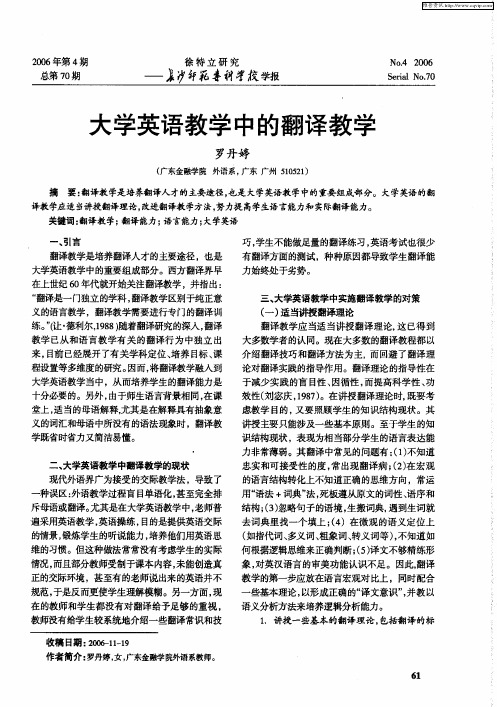
一
有翻译方面的测试 ,种种原因都导致学生翻译能
力始终处于劣势 。
三、 大学英语教学中实施翻译教学的对策
( ) ቤተ መጻሕፍቲ ባይዱ 适当讲授翻译理论 翻译教学应 当适 当讲授翻译理论, 已得到 这 大多数学者 的认 同。现在大多数的翻译教程都 以
两种手段时又要贯彻“ 能直译便直译 , 不能直译便
例如翻译徐志摩 的《 再别康桥》 。教师首先要 讲述相关的社会和创作背景 ,提醒学生除了注意 词、 句的翻译 , 还要注意文学翻译的独特性。有学 生将“ 轻轻的我走 了 , 正如我轻轻的来 , 我轻轻的 招手 , 作别西天 的云彩 ” 译为 :lt u t , h h Ie il w i fq ey c
介绍翻译技巧和翻译方法为主, 而回避 了翻译理
论对翻译实践的指导作用 。翻译理论的指导性在 于减少实践的盲 目性、 因循性 , 而提高科学性 、 功 效性( 刘宓庆 ,97 。在讲授翻译理论时, 18 ) 既要考 虑教学 目的, 又要照顾 学生的知识结构现状 。其 讲授主要只能涉及一些基本原则。至于学生的知
种误区: 外语教学过程盲 目 单语化 , 甚至完全排
斥母语或翻译。 尤其是在大学英语教学中, 老师普 遍采用英语教学 , 英语操练, 目的是提供英语交际 的情景 , 锻炼学生的听说能力 , 培养他们用英语思
维的习惯。但这种做法常常没有考虑学生的实际 情况, 而且部分教师受制于课本 内容 , 未能创造真 正的交际环境 ,甚至有 的老师说出来的英语并不 规范, 于是反而更使学生理解模糊 。另一方面, 现 在的教师和学生都没有对翻译给予足够 的重视 , 教师没有给学生较系统地介绍一些翻译常识和技
语法翻译法(最全版)PTT文档

语法翻译法的典型教学流程
复习
教授新词
教授语法
布置作业
巩固练习 讲解课文
传统语法翻译法的教学特点
1、教学目的是培养学生阅读外语范文(特别 是古典文学作品)和模仿范文进行写作的 能力,以应试为目的。
2、翻译是教学的基本手段。外语翻译成母语, 母语译成外语的逐词翻译是教学的基本手 段。外语知识的讲解、练习、巩固和阅读 技能的培养都采用翻译方法。
舌 tongue 鼻 nose 牙齿 teeth 它的出现为建立外语教学法作为一门独立的科学体系奠定了基础” 。
5、教师权威性不利于课堂教学开展。
翻译法重视语言知识的传授,忽视口语教学,为了完善翻译法,便产生了自觉对比法。
语法词汇: 5、文学语言优于口语;
3、课堂教学简洁方便,易于教室管理。
名词 noun 动词 verb 其代表人物为奥朗多弗(H.Ollendorff)和雅科托(Jacotot)等。
产生及盛行的原因
1、学习拉丁文是为了能够读懂该文字撰写的 经典作品以及官方文件,于是阅读成为学习 外语的首要任务。
机械原子观 2、古典语言教学意在对学习者进行智力和思 维训练,人们认为语法是训练思维的最佳材 料。
3、机械主义哲学在当时学术界占统治地位。 该主义认为:一切语言源于同一种语言,它 们拥有共同的语法及词汇概念,差别仅表现 为发音和书写形式的不同。
4、易于检验学习成果, 对教师要求降低。
语法翻译法在对外汉语教学中的应用
2、古典语言教学意在对学Байду номын сангаас者进行智力和思维训练,人们认为语法是训练思维的最佳材料。
案例1: 老师,这个怎么说?America。
学生很少提问,学生之间交流更少。 所谓自觉是通过语言分析以理解所学材料的内容含义,是指学生把注意力集中于语言形式本身,而不是这些语言形式所表达的思想内
何为语法翻译法[1]
![何为语法翻译法[1]](https://img.taocdn.com/s3/m/932ab065102de2bd960588ac.png)
何为语法翻译法一、语法翻译法的概念语法翻译法是为培养阅读能力服务的教学法,其教学过程是先分析语法,然后把外语译成本族语,主张两种语言机械对比和逐词逐句直译,在教学实践中把翻译当成教学目的,又当成教学手段。
二、语法翻译法的教学目的培养学生阅读外国文学作品的能力和模仿范文进行写作的能力。
三、语法翻译法的特点提倡用母语教授外语、在教学中以翻译为基本手段、以学习语法为人门途径、强调语法在教学中的中心地位。
四、语法翻译法的教学步骤1.先讲词法,后讲语法。
2.用演绎法讲授语法规则,即先讲语法规则,后举例句。
并翻译成本族语。
3.用本族语和外语互译的方法巩固所学的语法规则。
五、语法翻译法的优点1.学生语法概念清晰;2.阅读能力较强,尤其是遇到长而难的句子时通过分析句子结构便能理解意思;3.有助于培养翻译能力和写作能力;4.在实际的教学中,语法翻译法的可操作性强,简便易行。
同时在教学测试上也更便于施考。
六、语法翻译法的局限性1.忽视口语教学,学生的语音语调差,不利于培养学生用外语进行交际的能力;2.语法翻译法的教学过程往往过于依赖教师,课堂气氛比较沉闷,学生常常提不起学习热情;3.语法翻译法使学生养成过分依赖母语,对使用外语进行交流不利;4.语法翻译法过于强调语法知识的传授,忽视了语言技能的培养;5.语法翻译法使用的教材和课文往往因为源于文学作品,不仅难度过大,而且脱离语言运用的实际,无法引起学生学习的兴趣;七、语法翻译法的改进及发展趋势1.加强听说训练,培养学习者综合语言能力;2.重视学习者个人差异,激发学生的学习热情;3.采用灵活多变的教学方式;4.教学方法的折中融合如前所述,语法翻译法自产生之日起就呈现出发展的态势。
它至今仍存在于课堂教学证明了它的生存力和适应性。
外语教学方法之语法翻译法、直接发、听说法、交际法
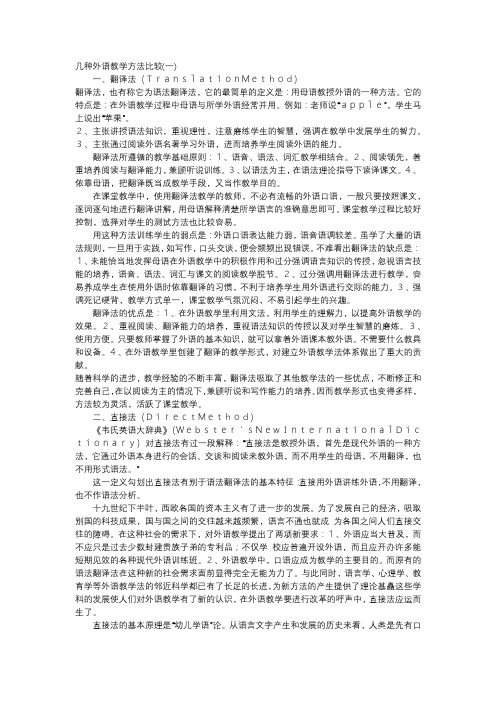
几种外语教学方法比较(一)一、翻译法(TranslationMethod)翻译法,也有称它为语法翻译法,它的最简单的定义是:用母语教授外语的一种方法。
它的特点是:在外语教学过程中母语与所学外语经常并用。
例如:老师说“apple”,学生马上说出“苹果”。
2、主张讲授语法知识,重视理性,注意磨练学生的智慧,强调在教学中发展学生的智力。
3、主张通过阅读外语名著学习外语,进而培养学生阅读外语的能力。
翻译法所遵循的教学基础原则:1、语音、语法、词汇教学相结合。
2、阅读领先,着重培养阅读与翻译能力,兼顾听说训练。
3、以语法为主,在语法理论指导下读译课文。
4、依靠母语,把翻译既当成教学手段,又当作教学目的。
在课堂教学中,使用翻译法教学的教师,不必有流畅的外语口语,一般只要按照课文,逐词逐句地进行翻译讲解,用母语解释清楚所学语言的准确意思即可。
课堂教学过程比较好控制,选择对学生的测试方法也比较容易。
用这种方法训练学生的弱点是:外语口语表达能力弱,语音语调较差。
虽学了大量的语法规则,一旦用于实践,如写作,口头交谈,便会频频出现错误。
不难看出翻译法的缺点是:1、未能恰当地发挥母语在外语教学中的积极作用和过分强调语言知识的传授,忽视语言技能的培养,语音、语法、词汇与课文的阅读教学脱节。
2、过分强调用翻译法进行教学,容易养成学生在使用外语时依靠翻译的习惯,不利于培养学生用外语进行交际的能力。
3、强调死记硬背,教学方式单一,课堂教学气氛沉闷,不易引起学生的兴趣。
翻译法的优点是:1、在外语教学里利用文法,利用学生的理解力,以提高外语教学的效果。
2、重视阅读、翻译能力的培养,重视语法知识的传授以及对学生智慧的磨炼。
3、使用方便。
只要教师掌握了外语的基本知识,就可以拿着外语课本教外语。
不需要什么教具和设备。
4、在外语教学里创建了翻译的教学形式,对建立外语教学法体系做出了重大的贡献。
随着科学的进步,教学经验的不断丰富,翻译法吸取了其他教学法的一些优点,不断修正和完善自己,在以阅读为主的情况下,兼顾听说和写作能力的培养。
大学英语翻译教学的问题和策略

大学英语翻译教学的问题和策略【摘要】文章对大学英语翻译教学的现状进行了调查研究,发现大学英语翻译教学在教学目标、教学内容、教学方法以及教学评价等方面存在着诸多问题。
在此基础上,作者对各个问题进行分析并且对大学英语翻译教学的研究和发展提出了相应的改进策略。
【关键词】大学英语翻译教学问题策略翻译是大学英语教学中不可或缺的重要组成部分,翻译教学对提高翻译教学水平有着直接的推动作用,也决定着翻译人培养的整体水平和未来发展。
早在上世纪60年代,翻译教学就受到了西方翻译界的关注,让·德利尔在《翻译理论与翻译教学法》中指出:翻译是一门独立学科,翻译教学区别于纯正意义的语言教学,翻译教学需要进行专门的翻译训练。
然而,在我国,相较于大学英语教学本身,大学英语翻译教学一直没有受到足够的重视。
翻译教学实践的蓬勃发展大家有目共睹,但是,翻译教学的理论研究相对滞后。
近一二十年来,翻译教学的论文发表数量呈上升趋势,但系统的翻译教学理论专著未见出版。
相关研究一直停留在简单的经验总结上,既不系统也不全面。
究其原因是多方面的,这篇文章将会就这些问题进行简要的探讨并给出相应的解决策略。
一大学英语翻译教学现存的问题1.相关研究不足,教学目标模糊对于翻译教学,迄今为止没有形成完整系统的理论,更没有研究出系统化的教学法,以至在教学中形成“八仙过海各显神通”的局面。
教材的编写也存在各种各样的差异,教学效果自然参差不齐,总体来说不够理想。
甚至不少老师认为翻译课不过是为外语专业学生提供的一种强化语言知识的途径,翻译课带有很大的随意性和盲目性。
学生和教师对大学英语翻译教学的概念和目标都不甚了解。
很多学生虽然对英语翻译学习很感兴趣,却不清楚学习的目的和方法。
而相当多的老师则把大学英语翻译教学当做语言教学的一种手段而非目的。
在英语翻译教学实践中,他们过多地强调翻译的技巧或者方法,在翻译理论的讲解上往往一笔带过,最终使得翻译教学沦为语法教学的附庸。
翻译法直接法教学英语比较-最新教育资料
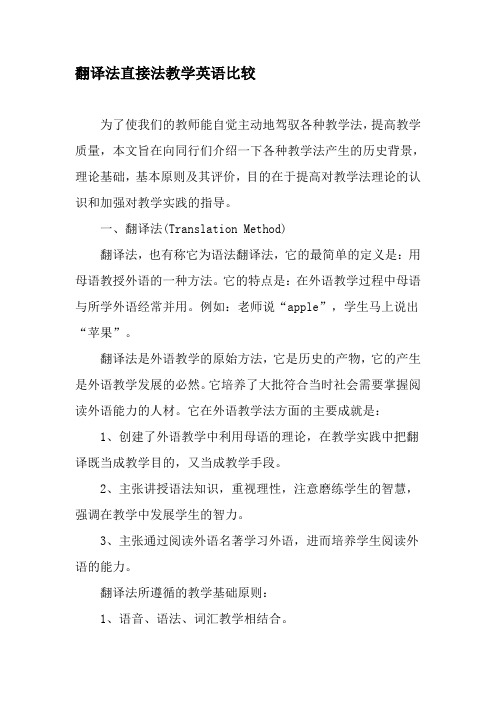
翻译法直接法教学英语比较为了使我们的教师能自觉主动地驾驭各种教学法,提高教学质量,本文旨在向同行们介绍一下各种教学法产生的历史背景,理论基础,基本原则及其评价,目的在于提高对教学法理论的认识和加强对教学实践的指导。
一、翻译法(Translation Method)翻译法,也有称它为语法翻译法,它的最简单的定义是:用母语教授外语的一种方法。
它的特点是:在外语教学过程中母语与所学外语经常并用。
例如:老师说“apple”,学生马上说出“苹果”。
翻译法是外语教学的原始方法,它是历史的产物,它的产生是外语教学发展的必然。
它培养了大批符合当时社会需要掌握阅读外语能力的人材。
它在外语教学法方面的主要成就是:1、创建了外语教学中利用母语的理论,在教学实践中把翻译既当成教学目的,又当成教学手段。
2、主张讲授语法知识,重视理性,注意磨练学生的智慧,强调在教学中发展学生的智力。
3、主张通过阅读外语名著学习外语,进而培养学生阅读外语的能力。
翻译法所遵循的教学基础原则:1、语音、语法、词汇教学相结合。
2、阅读领先,着重培养阅读与翻译能力,兼顾听说训练。
3、以语法为主,在语法理论指导下读译课文。
4、依靠母语,把翻译既当成教学手段,又当作教学目的。
在课堂教学中,使用翻译法教学的教师,不必有流畅的外语口语,一般只要按照课文,逐词逐句地进行翻译讲解,用母语解释清楚所学语言的准确意思即可。
课堂教学过程比较好控制,选择对学生的测试方法也比较容易。
用这种方法训练学生的弱点是:外语口语表达能力弱,语音语调较差。
虽学了大量的语法规则,一旦用于实践,如写作,口头交谈,便会频频出现错误。
不难看出翻译法的缺点是:1、未能恰当地发挥母语在外语教学中的积极作用和过分强调语言知识的传授,忽视语言技能的培养,语音、语法、词汇与课文的阅读教学脱节。
2、过分强调用翻译法进行教学,容易养成学生在使用外语时依靠翻译的习惯,不利于培养学生用外语进行交际的能力。
3、强调死记硬背,教学方式单一,课堂教学气氛沉闷,不易引起学生的兴趣。
在大学英语教学中加强英语翻译教学

在大学英语教学中加强英语翻译教学作者:胡珊珊刘妍张颖来源:《群文天地》2012年第02期摘要:目前,在大学英语教学中,英语翻译教学存在着思想与方法相对陈旧、教师缺乏翻译教学经验、学生语言基本功不强等问题。
为改变大学英语翻译教学的现状,必须转变观念,充分重视翻译教学,讲解翻译技巧,鼓励学生自主学习,提高学生英语翻译能力。
关键词:大学英语教学;翻译教学;翻译能力一、大学英语翻译教学的现状目前在大学英语教学中存在翻译教学思想与方法相对陈旧的问题。
大学英语教学的任务就是培养学生语言运用能力,翻译教学是培养学生的语言理解能力和表达能力的重要途径,然而在近些年的大学英语教学中,翻译教学在一定程度上受到冷落。
目前大学英语教学中过多的强调听力与阅读能力的培养和训练,而忽视翻译教学。
教学思想、教学模式、教学方法相对陈旧与单一。
在教学思想上教师过分依赖教学大纲,缺少灵活性。
教学模式与教学方法基本上沿用老一套,讲授多于实践。
翻译教学局限在黑板上,满堂灌,记笔记,做作业,对标准答案。
这种教学方法与模式既不利于调动和发挥学生自主学习的积极性,也违背语言学习规律,不利于学生英语水平的提高。
在实际翻译中,语篇是翻译的对象和基本单位。
英语读者和汉语读者生活在不同的文化环境,在知识结构上自然存在着不少差别,对语篇中信息的理解和接受也会有所不同。
对于我国学生如何处理这种英汉两种文化的差异、跨越语言鸿沟,是翻译过程中的一大难题,也是影响翻译能力提高的一大障碍。
语言基本功是否扎实也影响着学生翻译能力的提高。
翻译要求具备多方面的知识,它包括译者的汉语知识和英语知识,其中汉语知识包括语法、修辞、逻辑,英语知识除了语法、修辞、逻辑知识以外,还要注意不断吸收和丰富各种基础理论知识,学生应学会如何把这些基础的知识灵活地运用到翻译过程中去。
当然,除了文化环境的差异和语言基本功是否扎实等因素外,教师在教学过程中如何引导学生进行翻译,教师对学生翻译能力培养的重视程度等也会影响学生翻译能力的提高。
学习翻译的四条途径和三个层面

学习翻译的四条途径和三个层面1.“互文性”对翻译学习的启示一个语篇至少在三个方面与其他语篇产生联系。
第一,它与某些语篇共同遵循着某种格式和结构规范;第二,它的内容和某些语篇的内容有联系,包括直接或间接引用了其他语篇;第三,它与某些语篇属于同一文化/宗教/思想传统。
这在诒篇语言学了被称为互文性。
互文性的概念向我们提示了语篇的两个重要属性:一、主篇是聚合成不同类型的,各自发挥不同的交际功能;同类语篇共同遵循在套行文和交际规范;二、语篇间相互依存,形成交际参与者所共享的一套知识结构和交际语境。
将这一思想运用于翻译,便呈现如下的互文关系:world of SL texts←→ST←→TT←→world of TL texts原文(ST)是源语语篇世界(world of SL texts)中的一员,与其中某些语篇具有密切的互文关系;原文(ST)引发译文(TT)的生成,两者间存在渊源关系;而译文(TT)的生成受到译语语篇世界(world of TL texts)的导向和制约,这又是一层互文关系。
用这一思想指导翻译学习,可提出以下四条有效的途径。
2.四条途径目的语阅读:阅读与所译语篇同一/相似类型的目的语语篇。
译文,作为在新的语境中行使交际功能的语篇,它的互文性首先体现在要适应译文读者的预期上。
因为译文一旦进入目的语,便成为目的语语篇世界中的一员。
它必须与目的语中的原创语篇,尤其是同一类型的原创语篇相比照而存在,要有效地心向往之交际功能,它就必须在很大程度上符合目的语同类/相近语篇的写作规范。
而掌握这种规范的最佳途径就是进行充分的目的语阅读。
另外,译文还会与业已存在的同一/相似类型的翻译语篇相比照而存在,阅读此类翻译语篇有助于学习者在翻译实践中摸索和确立自己应遵循的目的语语言、语体和语用规范。
在阅读的基础上还不妨进行少量目的语写作练习。
翻译研究文化学派的A.Lefevere将翻译看作是一种“重写”(rewriting)过程。
“信、达、雅”视域下英语翻译教学优化途径探讨

“信、达、雅”视域下英语翻译教学优化途径探讨作者:陈婷婷来源:《陕西教育·高教版》2020年第04期[摘要]“信、达、雅”为我国译界翻译原则,强调翻译要忠实本意,译文既要表达流畅,又要准确、完整地表达原文思想。
高校应将“信、达、雅”理念贯彻于英语翻译教学,使学生认识翻译标准,树立正确目标,为职业生涯发展奠定语言基础。
本文以“信、达、雅”内涵为基础,以翻译教学实践为例,研究“信、达、雅”理念在英语翻译教学中的指导作用,探索英语翻译教学的优化措施。
[关键词]“信、达、雅”;翻译教学;人才培养引言翻译是不同语言背景的人们实现交流、增进了解的必要工具。
不同语言背景的人能否充分、准确理解对方所表达的信息,很大程度上取决于语言的翻译。
翻译是人类沟通的纽带,“信、达、雅”是译者心之所向,自其问世,就成为译界评价翻译质量的标尺。
高校翻译教学应注重对学生“信、达、雅”理念及翻译技能的培养,使学生掌握语言翻译这一锐器。
“信、达、雅”理念的蕴涵“信”指译文要忠实于原文原意,并能准确表达原文承载的信息。
译文和原文虽语言形式不同,但所表内容应根本一致,不掺杂译者对信息的扩充或筛选,体现翻译的忠实性原则。
如贾平凹所著《浮躁》中某些体现陕西地域文化的詞语,在英语中无对等译词,甚至在中国其他方言中也属罕见:“福运瓷了好久”,译为“Fuyun just stood there for a while”就保持了原意,即“好运气只能短暂停留,不会太久”。
英译体现了忠实性,读者也易理解,符合“信”之要求。
“达”指译文表达要通顺、流畅、自然,符合译文语言习惯表达,使目的语读者自然接受译文表达。
相较于“信”,“达”要求译者进行适当变通,即“连贯性原则”。
如“扶不起的阿斗”,若拘泥于原文直译,易被认为是阿斗摔倒了扶不起,而非其真正含义。
“达”要求译者既做到准确翻译,又具备必要的语言文化基础,结合语境适当翻译。
“雅”指译文在准确的翻译基础上,表达地道、文笔优美,符合语言习惯,体现语言魅力,使交流双方(作者与读者)能达到内心情感的共鸣。
关于大学英语教学中开展翻译教学的探讨

团
敏 “ 2. (删) t0 中 37 t 3  ̄
口 张 敏 杨蔚 君
00 1 ) 302 ( 太原 师 范学院 山西 ・ 太原
关于大学英语教 学中开展翻译教 学的探讨
摘 要 本文通过对非英语 专业学生进行的调查问卷 以及 《 全新版大学英语综合教程 》 的教 学实践探讨在新的教学大纲 要 求 下 大学 英语 翻 译 教 学 的 必要 性 和 开展 的方 法 及途 径 。 关键词 大学英语 翻译教 学 必要性 方 法
文章编号: 6 2 7 9 2 0 0 - 2 - 2 1 7 - 8 4( 0 8J 7 1 0 0 能是听、 、 、 说 读 写这四种技能的综合反映。 翻译行为包括两个过程 : 理解和表达 。这就要求学生首先要正确理解原文 , 只有这样才能够 准确地翻译 , 因为阅读理解是表达的基础 。翻译训练可 以帮助学生 更加明确地意识 到两种语言 的特点 以及它们所折射 的两种文化 的 差异 , 而提高对所学语言 的敏感程度, 从 加深对英语和汉语的理解 。 而通过翻译 的准确与否又可以考查学生是否正确地理解 了原文 。 同 时, 翻译也是 一种再现行为 , 即对原作者 的意 图、 作方式 、 写 遣词造 句等的再现 。通过翻译 练习, 学生可以提高对文章的分析和鉴赏能 力 ,这样 不仅可 以提高 翻译能力 而且对写作能力 的提 高也 大有裨 益。 此外。 口头翻译练 习不但可以锻炼学生的语言思维能力 、 通过 遣 词造句的能力 , 而且锻炼 了学生的 口头表达能力。 其次 , 从学生常犯的错误来看。 翻译教学显得尤为必要和紧迫 。 在教授 《 全新版大学英语 》 的过程 当中, 笔者有意让学生们尝 试对人选课文的某些词句进行翻译 , 从学生 的英译 汉中发现了一些 问题。 正如英 国语言学家 T w l o e 所指出的 “ l 学第二语言者把第一语 言的特点迁移 ( as r 到第 二语言 中是第二语言习得中的普遍现 t nf ) r e 象 ( evs eet e) prai au 。这种迁移影响到语言的各个层 面。” vf r
翻译视角下的英语教学分析——以中学课堂为例

翻译视角下的英语教学分析——以中学课堂为例翻译活动作为常见的对外交际方式,从古至今在对外交流方面一直占据着重要的地位。
但对于中国学生来说,英语学习并不是一蹴而就的,学生从中学时期开始就应该打下良好的翻译基础。
1在中学英语教学中培养翻译能力的重要性中学是学生学习英语的基础时期和过渡时期,绝大多数学生在上初中后才系统地学习英语音标、语法、时态等。
所以此阶段对于学生的英语学习非常重要,对于学生将来的英语成绩提升、自身的发展有着极大的影响力。
1.1翻译是学习英语的阶石《普通高中英语课程标准(2017年版)》中明确提出:“语言技能是语言能力的重要组成部分。
语言技能包括听、说、读、看、写等方面的技能。
听、说、看是理解性技能,说和写是表达性技能。
理解性技能和表达性技能在语言学习过程中相辅相成、相互促进。
”(中华人民共和国教育部,2018)这导致中学教师缺乏对翻译训练的重视。
翻译应与听、说、读、看、写紧密结合起来,全方位地帮助学生提高英语综合能力,强化听、说、读、看、写能力,还原学生学习的主体性,将知识从输入转化为输出。
从社会语言学的角度来说,语言学习不仅是要提高学习者对该目标语言的语音、语法及词汇的运用能力,还要求学习者能习得或创设类似于真实生活的语境,并在这个过程中提高跨文化交际的能力(阎佩衡,2015)。
本研究所指的翻译并不是指字对字、词对词地进行信息转换,也不是指对文字进行仔细推敲、斟酌。
对于中学生而言,只要完成基本的直译即可。
通过翻译练习,学生在语境中领会单词的用法与含义,并通过句子去学习单词,避免机械式记忆,减少学习英语的枯燥感。
同时翻译训练还能潜移默化地加深学生对英语句子成分、结构和词汇搭配的理解。
翻译训练对于写作也有一定的促进作用,通过长期大量的句子翻译练习,学生面对写作时就不易出现“无话可说、无词可选”的情况。
通过涉及多个领域的翻译,学生可逐渐在脑海中形成各种英语的图式结构,这就是教师通常所说的“语感”。
语法翻译法(THEGRAMMARTRANSLATIONMETHOD)

对中国产生过影响的教学法流派及其优缺点一、语法翻译法(the Grammar Translation Method)语法翻译法对近代和当代语言教学产生重大影响,对中国外语教学的影响达数十年。
语法翻译法也叫古典法,它因曾经用来教授古典语言希腊语和拉丁文而得名。
16 ~17 世纪,处于文艺复兴中心的欧洲人崇尚古典文化,学习拉丁文,通过阅读来继承文化遗产。
18 世纪以后,以英语和法语为代表的现代语言作为外语取代拉丁文,但其教学方法仍然沿用教授拉丁文时的方法,因为当时的语言学家认为:世界上大多数语言源于同一种语言,词汇概念和语法结构都是相同的,通过“等值翻译”可以实现不同语言之间的理解和沟通。
语法翻译法以翻译作为手段来处理课文教学:课堂上用母语来组织教学,用外语或母语来回答问题,将课文逐句翻译成本族语,培养学生阅读外语原文的能力;用演绎法处理语法,句子是教学与练习的基本单位,要求学生背诵语法规则和例句,通过母语和外语之间的比较来理解抽象词汇、句子意义和句法结构;用书面形式来设疑答问,问题的设计停留在语言的表层结构,答案直接从课文中找到;用直觉思维来应对检测,句子是练习的基本单位,借助“题海战术”进行单一的形式练习,就能获得“满意”的成绩。
语法翻译法从20 世纪初就开始影响我国的外语教学,经过几十年的实践运用,我国教师运用“语法翻译法”颇有心得,将其总结为“八字诀”,即“读( 课文) ”、“译( 句子) ”、“讲( 语法规则) ”、“问( 提问) ”、“背( 规则) ”、“练( 习) ”、“记 ( 单词) ”、“测 ( 试) ”。
上课之初,每个学生都有可能被要求朗读课文中的几行文字,然后将所读的内容逐句译成汉语。
当学生阅读完段落并将其翻译为母语之后,学生举手就所存在的问题提问,老师回答,讲解或造句示范。
解决学生存在的问题之后,教师开始讲解课文中重要的语法点,要求学生背记规则。
接着做课文后的练习题,练习的内容就课文设计的问题进行书面答问,英汉、汉英翻译练习,填空选择练习等,或是要求学生抢记单词,最后进行分课小测验。
语法翻译法

含义
语法翻译法——又称“传统法”、“古典 法”、“旧式法”、“阅读法”或“普鲁士 法”,是以系统的语法知识教学为纲,提倡用 母语教授外语,在教学中以翻译为基本手段, 以学习语法为入门途径,强调语法在教学中的 中心地位,主要培养第二语言读写能力的教学。
教学手段——翻译,用母语去翻译目的语 教学内容——系统的语法规则
基本特点
以系统的语法知识为外语教学的基础,采用演 绎的方式进行语法教学,对语法规则进行详细 的分析,要求学生熟记并通过翻译练习加以巩 固语。 ② 用母语教学,翻译(外—母,母—外)是主要 的教学手段、练习手段和评测手段。 ③ 注重阅读和写作能力的培养,强调阅读原著和 名著,注重书面语的学习,不注重口语。 ④ 重视理性,强调通过外语教学发展学生的智力。
语法翻译法
产生
语法翻译法产生于中世纪盛行于15至17世纪 的欧洲; 当时欧洲人教希腊语和拉丁语所采用的方 法,到18世纪,英语、法语、意大利语等现代 语言兴起,但仍沿用这一古老的教学方法;
在18世纪末19世纪初,德国语言学家奥伦 多夫等学者对语法翻译法惊醒了理论上的总结 和阐述,使之成为一种科学的第二语言教学法 体系。
理论基础
*语言学基础——历史比较语言学,又称比较语言学,起 源于18和19世纪的欧洲。认为把有关各种语言放在一 起加以共时比较或把同一种语言的历史发展的各个不 同阶段进行历时比较,以找出它们之间在语音、词汇、 语法上的对应关系和异同的一门学科。因此掌握两种 语言词汇的互译和语法关系的替换就能掌握另一种语 言。 *心理学基础——官能心理学,其创始人是18世纪德国哲 学家的沃尔夫,认为心灵虽是统一,但能划分为不同 的官能或能力,如认识、情感、意志等。他把人的心 理官能分为两大类:一类是认知官能,包括感觉、想 像、记忆、注意、悟性(形成、区分和判断一般概念) 和理性(由纯概念推出结论)。另一类官能是欲求官 能,包括愉快和不愉快的感情和意志作用。心理的各 种官能可分别加以训练。如拉丁语语法可翻译法、语法法和词汇-翻译法都 属于同一类方法。它最初用来学习古希腊文和 拉丁文这类死的语言,后来用来学习现代外语 (本世纪初,这种教学法在许多国家的外语教 学中占主导地位。我国解放初期的外语级学, 特别是俄语教学,大都采用这种方法)。
方案英文怎么说

方案英文怎么说方案是一个日常生活中经常用到的词汇,它可以指代各种策划、计划、计谋以及解决问题的方法。
在英语中,"方案"一词可以用多个单词或短语来表达,下面将为大家介绍一些常见的表达方式。
一、"solution"是最常见的翻译之一。
它可以表示解决问题的方法或策略。
例如,在公司中,针对某个具体问题,我们可以使用"proposed solutions"(提议的解决方案)来描述我们针对该问题提出的解决途径。
二、"approach"也经常用来表达方案的意思。
它强调解决问题的方法或途径。
例如,我们可以使用"alternative approaches"(替代方法)来描述不同的解决方案。
三、"strategy"是指制定规划和行动步骤的策略。
在一些复杂的情况下,我们需要仔细考虑采取什么样的"strategy"才能最佳地解决问题。
四、"plan"可以指具体的计划或行动方案。
例如,当我们在制定某个项目的详细步骤时,我们可能需要准备一个"implementation plan"(实施计划)。
五、"method"则强调一种具体的方法或操作步骤。
例如,我们可以使用"teaching methods"(教学方法)来描述不同的教学策略和方式。
六、"proposal"通常用于指代提议或计划的文档。
在商业场景中,我们会遇到"business proposals"(商业提案)或者"project proposals"(项目提案)。
七、另外一种表达方式是"action plan",它专注于具体的行动计划,强调实施步骤和时间安排。
在实施项目或完成某项任务时,我们通常会制定一个详细的"action plan"来指导实施。
语法翻译法
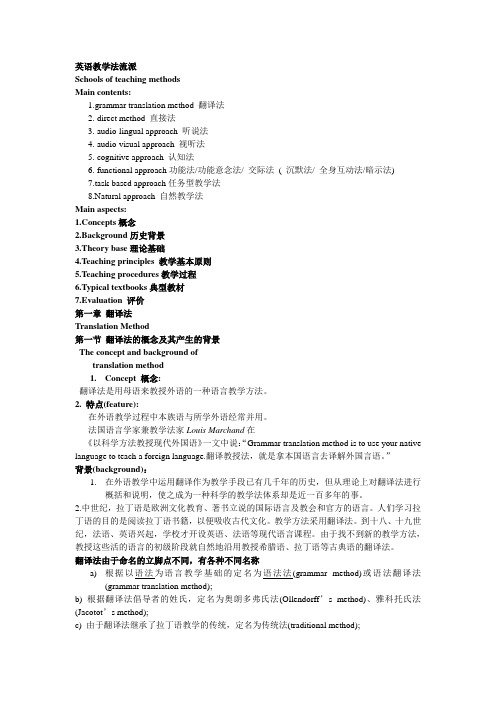
英语教学法流派Schools of teaching methodsMain contents:1.grammar translation method 翻译法2. direct method 直接法3. audio-lingual approach 听说法4. audio-visual approach 视听法5. cognitive approach 认知法6. functional approach功能法/功能意念法/ 交际法( 沉默法/ 全身互动法/暗示法)7.task-based approach任务型教学法8.Natural approach 自然教学法Main aspects:1.Concepts概念2.Background历史背景3.Theory base理论基础4.Teaching principles 教学基本原则5.Teaching procedures教学过程6.Typical textbooks典型教材7.Evaluation 评价第一章翻译法Translation Method第一节翻译法的概念及其产生的背景The concept and background oftranslation method1.Concept 概念:翻译法是用母语来教授外语的一种语言教学方法。
2.特点(feature):在外语教学过程中本族语与所学外语经常并用。
法国语言学家兼教学法家Louis Marchand在《以科学方法教授现代外国语》一文中说:“Grammar translation method is to use your native language to teach a foreign language.翻译教授法,就是拿本国语言去译解外国言语。
”背景(background):1.在外语教学中运用翻译作为教学手段已有几千年的历史,但从理论上对翻译法进行概括和说明,使之成为一种科学的教学法体系却是近一百多年的事。
翻译研究的功能语言学途径

翻译研究的功能语言学途径翻译是连接不同语言和文化之间的桥梁和纽带,是文化交流和相互理解的重要工具。
翻译研究作为一个跨学科的领域,在不同学科的合作交流中不断发展,其中功能语言学途径作为一种重要的研究方法,具有其独特的价值和意义。
功能语言学途径是指通过语言的功能来理解和描述其结构和使用的方法。
这种途径强调语言使用者的意图和目的,关注语言的功能和意义,而不仅仅是关注语言的形式和结构。
在翻译研究中,功能语言学途径可以帮助我们更好地理解和分析翻译过程和成果,揭示语言和文化之间的联系和转化。
首先,功能语言学途径可以帮助研究者分析翻译中的语言功能。
翻译作为一种跨语言和跨文化的传递过程,语言的功能在其中起着至关重要的作用。
通过功能语言学途径,研究者可以分析源语言和目标语言之间的功能差异和转化,深入探讨语言之间的关系和交流方式。
例如在汉英翻译中,中国人倾向于使用间接的表达方式,而英语则更注重直接表达,这种功能差异对翻译过程和成果产生了重要影响。
功能语言学途径可以帮助我们理解这种差异的原因和意义。
其次,功能语言学途径可以帮助研究者分析翻译的整体效果和目的。
翻译的目的通常是将一个语言文化转化为另一个语言文化,以实现沟通和理解。
通过功能语言学途径,研究者可以关注翻译的效果和目的,分析翻译中所使用的语言手段和策略。
例如,在音乐翻译中,翻译者可以通过选择合适的语言风格和表达方式,使得目标受众能够更好地理解和欣赏源语言歌词的意义和情感。
功能语言学途径可以帮助我们理解这种选择的背后逻辑和目的。
再次,功能语言学途径可以帮助研究者分析翻译中的语言变异和变化。
翻译涉及不同语言和文化之间的转换和转化,语言的变异和变化是其重要特征之一。
通过功能语言学途径,研究者可以探讨翻译中语言变异的原因和意义,揭示不同语言和文化之间的异同和联系。
例如,在汉英翻译中,由于语言和文化的不同,有些表达方式无法直接转换,需要通过其他语言手段来进行转化。
功能语言学途径可以帮助我们理解这种变异和转化的规律和原因。
交互式教学模式下学生英语翻译能力的培养途径
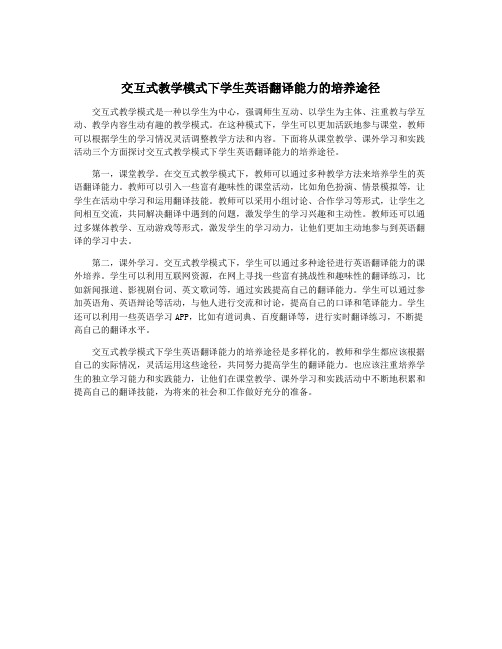
交互式教学模式下学生英语翻译能力的培养途径交互式教学模式是一种以学生为中心,强调师生互动、以学生为主体、注重教与学互动、教学内容生动有趣的教学模式。
在这种模式下,学生可以更加活跃地参与课堂,教师可以根据学生的学习情况灵活调整教学方法和内容。
下面将从课堂教学、课外学习和实践活动三个方面探讨交互式教学模式下学生英语翻译能力的培养途径。
第一,课堂教学。
在交互式教学模式下,教师可以通过多种教学方法来培养学生的英语翻译能力。
教师可以引入一些富有趣味性的课堂活动,比如角色扮演、情景模拟等,让学生在活动中学习和运用翻译技能。
教师可以采用小组讨论、合作学习等形式,让学生之间相互交流,共同解决翻译中遇到的问题,激发学生的学习兴趣和主动性。
教师还可以通过多媒体教学、互动游戏等形式,激发学生的学习动力,让他们更加主动地参与到英语翻译的学习中去。
第二,课外学习。
交互式教学模式下,学生可以通过多种途径进行英语翻译能力的课外培养。
学生可以利用互联网资源,在网上寻找一些富有挑战性和趣味性的翻译练习,比如新闻报道、影视剧台词、英文歌词等,通过实践提高自己的翻译能力。
学生可以通过参加英语角、英语辩论等活动,与他人进行交流和讨论,提高自己的口译和笔译能力。
学生还可以利用一些英语学习APP,比如有道词典、百度翻译等,进行实时翻译练习,不断提高自己的翻译水平。
交互式教学模式下学生英语翻译能力的培养途径是多样化的,教师和学生都应该根据自己的实际情况,灵活运用这些途径,共同努力提高学生的翻译能力。
也应该注重培养学生的独立学习能力和实践能力,让他们在课堂教学、课外学习和实践活动中不断地积累和提高自己的翻译技能,为将来的社会和工作做好充分的准备。
翻译范文教学目标
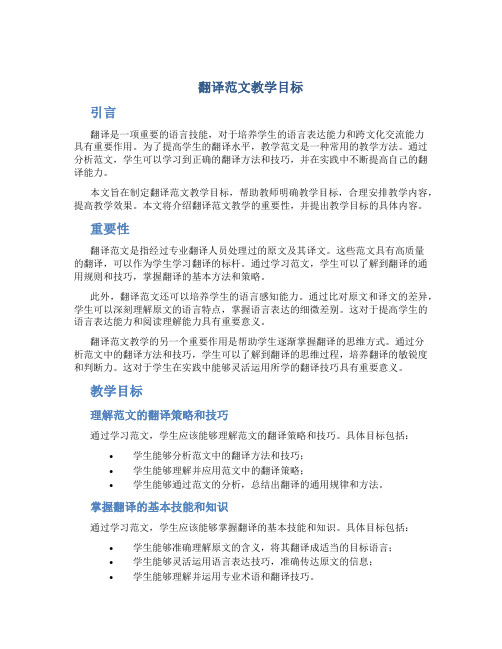
翻译范文教学目标引言翻译是一项重要的语言技能,对于培养学生的语言表达能力和跨文化交流能力具有重要作用。
为了提高学生的翻译水平,教学范文是一种常用的教学方法。
通过分析范文,学生可以学习到正确的翻译方法和技巧,并在实践中不断提高自己的翻译能力。
本文旨在制定翻译范文教学目标,帮助教师明确教学目标,合理安排教学内容,提高教学效果。
本文将介绍翻译范文教学的重要性,并提出教学目标的具体内容。
重要性翻译范文是指经过专业翻译人员处理过的原文及其译文。
这些范文具有高质量的翻译,可以作为学生学习翻译的标杆。
通过学习范文,学生可以了解到翻译的通用规则和技巧,掌握翻译的基本方法和策略。
此外,翻译范文还可以培养学生的语言感知能力。
通过比对原文和译文的差异,学生可以深刻理解原文的语言特点,掌握语言表达的细微差别。
这对于提高学生的语言表达能力和阅读理解能力具有重要意义。
翻译范文教学的另一个重要作用是帮助学生逐渐掌握翻译的思维方式。
通过分析范文中的翻译方法和技巧,学生可以了解到翻译的思维过程,培养翻译的敏锐度和判断力。
这对于学生在实践中能够灵活运用所学的翻译技巧具有重要意义。
教学目标理解范文的翻译策略和技巧通过学习范文,学生应该能够理解范文的翻译策略和技巧。
具体目标包括:•学生能够分析范文中的翻译方法和技巧;•学生能够理解并应用范文中的翻译策略;•学生能够通过范文的分析,总结出翻译的通用规律和方法。
掌握翻译的基本技能和知识通过学习范文,学生应该能够掌握翻译的基本技能和知识。
具体目标包括:•学生能够准确理解原文的含义,将其翻译成适当的目标语言;•学生能够灵活运用语言表达技巧,准确传达原文的信息;•学生能够理解并运用专业术语和翻译技巧。
培养语言感知能力和文化意识通过学习范文,学生应该能够培养语言感知能力和文化意识。
具体目标包括:•学生能够理解不同语言表达的差异和细微差别;•学生能够准确把握原文中的文化要素,将其翻译成对应的目标语言表达;•学生能够通过范文的学习,加深对跨文化交流的理解和认识。
- 1、下载文档前请自行甄别文档内容的完整性,平台不提供额外的编辑、内容补充、找答案等附加服务。
- 2、"仅部分预览"的文档,不可在线预览部分如存在完整性等问题,可反馈申请退款(可完整预览的文档不适用该条件!)。
- 3、如文档侵犯您的权益,请联系客服反馈,我们会尽快为您处理(人工客服工作时间:9:00-18:30)。
翻译教学的描述途径Chang Nam Fung [作者惠寄]A Descriptive Approach to the Teaching of TranslationDepartment of Translation, Lingnan CollegeAbstractThere is no absolute truth about the “correct” way of translating, even with regard to a specific text for a specific purpose, correctness notions being determined by the values and attitudes of a culture, and there are competing sets of translational norms in any community at any time. The problem with the prescriptive approach adopted in the teaching of translation practice in tertiary institutions in Hong Kong is therefore that the norms adopted by the teacher to evaluate student works are either divorced from reality, if they are derived from mere theoretical speculation, or they just reflect the values of a certain section of the community, if they are derived from practical experience.In the first case the teacher is not doing much service to the community, and in the second case s/he is actually taking sides with one particular set of those competing norms. It may be in line with the Chinese tradition for the intelligentsia to be involved in norm-setting activities, but it seems to be inappropriate for the scholar to assume the role of the norm-setter in the classroom, teaching the norms upheld by his/her own school.It is argued that a more descriptive approach to the teaching of translation practice is not only possible, but also more effective in training competent translators. This approach aims at developing in students all-round language skills and translation skills, and, most important of all, an ability to apply these skills flexibly to satisfy the demands of their clients or their boss, or to seek their own ends. This ability must necessarily be based on a thorough understanding of all phenomena related to translation -- not just products, producers, initiators and receptors, but also the whole spectrum of linguistic and translational norms, their changeability over time, and all the socio-cultural factors that have contributed to the formation of these norms.1. The Prescriptive Approach to Translation TeachingAll the translation programmes run by tertiary institutions in Hong Kong at diploma and undergraduate levels attach paramount importance to the training of translators (and interpreters). Strictly speaking, theybelong to the domain of applied translation studies, which is an extension of translation studies proper, or “pure translation studies” in James S. Holmes’ typology, and the teaching of their practical courses seems to be more or less prescriptive or normative in nature.The main problem with this approach is: what are to be prescribed for students? What criteria are to be used to evaluate their translations? In other words, what kind(s) of translational norms are to be adopted in the classroom? And what should be the relation between these classroom norms and those operative in the community?My experience as a student and as a teacher tells me that there are sometimes a gap between what is taught in the classroom and what is required from the translation profession, as Lance Hewson and Jacky Martin observe:Students of translation tend to think of the ST as a definitive and somehow untouchable entity which must be preserved in translation at all costs. This is, of course, the result of certain attitudes taught in translation classes, particularly at university level when the ST is taken from a work of literature. It is quite understandable that the “beauty” of the ST is often evoked, but again the reality of the translating profession suggests a very different attitude towards the ST. This is not to say that there are “literary” (and untouchable) texts in one group, and “other”(somehow inferior) texts in another group, but quite simply that the teaching of translation does tend to exploit certain values which the professional will rarely find of use.This difference in values is clearly reflected in an English-Chinese translation exercise where the students were required to preserve all the cricket metaphors in a newspaper commentary on current affairs, on the ground that failure to preserve these metaphors would not be doing justice to the author. Practical questions such as the possible purpose of the translation, the potential venues of its publication and the comprehensibility of the text to its potential reader were simply not taken into account. It should be noted moreover that in this case source-oriented translational norms that are traditionally associated with literary classics were applied to a text that could be regarded as “vocative” in Peter Newmark’s classification of text types. In contrast, it seems safe to assume that the professional translator will most likely be required to produce a text that is comprehensible to a wide readership, if the text is to be published in a Chinese newspaper.It seems that this gap is not unnoticed in academia. Generally speaking, those who recognize its existence may take three different attitudes towards it:1. Academic training is different from vocational training. Thus,translational norms taught in universities should be established purely according to academic principles, and norms operative in the real world, tainted as they are by all kinds of practical considerations, should be of little concern to the scholar.2. The real world is full of imperfections. As academics we are in a position and have the duty to effect changes in the world. The very purpose of applied translation studies is exactly to make the quality of translations better, and this would involves the improvement of not only language and cultural competency and translation skills, but also translational norms.3. The teaching of translation should not be divorced from reality, and students should be trained to comply with norms operative in the real world so that they can become competent translators, for competency means the ability to do what one is expected to do by the community.If the first attitude is taken, reality can be conveniently ignored, and so can be the following discussion about translational norms. But this attitude seems to be futile because it regards the academic circle as a socio-cultural vacuum: since in a vacuum no action will lead to any consequence whatsoever, one set of norms is as good as any other and it does not matter which set is used.The second and the third attitudes take positions vis-à-vis norms operative in the real world, and therefore we must take a closer look at these norms before we can discuss the attitudes.2. Translational Norms and Norm-setting Activities“Translational norms are the social reality of concepts of translational correctness; this social reality secures the coordination concerning form and use of translational means in a socio-cultural community.” But these concepts of translational correctness in the real world are not homogeneous and static. They vary with the types of the source texts, to say the least. To evaluate the “correctness” of a translation of a newspaper commentary by norms that usually govern the translating of canonized literature is therefore likely to be counter-productive for the purpose of translator training.The commonly acknowledged “correct” way of translating a certain text also vary with the “prospective target situation”, or the “skopos”of the target text. Thus different translations of the same newspaper commentary may be needed for publication in a popular Chinese newspaper and for inclusion in a textbook of comparative cultural studies. Such correctness notions may differ even in relation to the same text translated for the same purpose. In other words, there exist what Gideon Toury calls “competing norms”:It is not all that rare to find side by side in a society three types of competing norms, each having its own followers and a position of its ownin the culture at large: the ones that dominate the center of the system, and hence direct translational behaviour of the so-called mainstream, alongside the remnants of previous sets of norms and the rudiments of new ones, hovering in the periphery. This is why it is possible to speak -- and not derogatorily -- of being “trendy”, “old-fashioned”or “progressive” in translation (or in any single section thereof) as it is in any other behavioural domain.But this does not seem to be a full account of the competing translational norms, because one obvious reason for their existence is that translation activities are anchored in a number of socio-cultural systems, such as the economic and the ideological besides the literary and the translational, and they put conflicting demands on the translator. A striking example is court interpreting in Hong Kong, where the “correctness” of the translation of certain idioms sometimes hinges on whether you are on the side of the prosecution or the defendant. For example, whether the word “整天” in “他整天陪我打牌” should be translated as “often” or “all day long” may be of vital importance for the establishment of an alibi, and a story goes that the defence counsel suggested that “幾大就幾大”, a Cantonese phrase usually used to express a determination to disregard the consequences of one’s action (which may be roughly equivalent to “豁出去了” in certain contexts), should be translated as “how big is how big” The purpose was of course to render the translation less damaging to the accused.The relative force of competing and conflicting norms is ultimately based on relations of power, with the result that those norms set or accepted by dominant sections of the community become the dominant norms. Where translation in the Chinese world is concerned, the dominant section, or the “institution”, is formed by publishers and editors, critics, employers, academics -- or the most influential sub-group among them, and sometimes even those in the centre of power in the community.The domination of a certain set of norms, however, is not absolute. Thus “the existence of a norm does not preclude erratic or idiosyncratic behaviour; nor can a norm prevent anyone from setting out deliberately to break it”, especially in fields with “relatively weak modalities of normative force and normative control”, such as literary translation; and an experienced and well-established translator may feel more confident than the young aspiring novice in ignoring the wishes and suggestions of norm-setters.It should have been made clear by now that there is no absolute truth about the “correct” way of translating, even with regard to a specific text for a specific purpose, for correctness notions are determined by the values and attitudes of a culture; that is, they are culture-bound. Synchronically, translational norms differ among cultures. When I tolda Chinese official that in the first draft of my translation of Jonathan Lynn and Antony Jay's Yes Prime Minister I had rewritten a certain passage with “anti-China” sentiments when I was looking for a publisher in the Mainland, he queried, “but do you have the right to do so?” But on another occasion a British scientist working in Australia remarked that it must have been an enormous task to find Chinese substitutes for all those British jokes; and when I explained that the most frequently used strategy in dealing with culture-specific items in the text was literal translation with or without inter- or extra-textual gloss, he commented, “then it is an academic translation.” It seems that their different concepts of translation reflect the translational norms dominant in their respective cultural polysystems.Diachronically, translational norms change in a particular culture. In the English-Chinese translation of place names, names of government officials, public notices and certain brand names in Hong Kong, there have been a gradual and continuous shift from foreignization to domestication since the 1950s. For example, the Chinese translation of the notice “Do not lean out of the window” was “請勿憑出窗外” on trams in the 1950s, and became “請勿將頭或手伸出窗外” on cable trams in the 1980s; “Philip Morris”, a cigarette brand name, was translated as “摩利士” in the 1950s, which was later changed to “摩哈利士”, and finally to “金徽 100” in the 1980s; and “司徒拔道” (Stubbs Road) was “史塔士道” some decades ago. One may conclude that these successive translations represent “progress” or “improvement” if one is to evaluate them by translational norms of the present time, but actually they are merely the products of different translational norms, and changes in these norms may have been partly due to the decline of British colonialism and the growth of Chinese nationalism, which is neither good nor bad from the translation scholar’s point of view.Now let’s return to the second and third attitudes mentioned above. In view of the existence of conflicting and competing translational norms, “norms operative in the real world” has to mean the set of norms dominant in the community. Therefore, if one takes the second attitude, one is dissatisfied with the dominant norms and wishes to modify them by, or even replace them with, norms that are in peripheral positions; and if one takes the third attitude, one is in fact protecting vested interests. In either case one is taking sides with one set of norms or another. In other words, one is engaged in norm-setting activities.Is it the business of academics to set norms? Some may argue that it is desirable, or at least inevitable, for them to involve themselves in social affairs, or even take part in social reform. And it seems to be in line with the good old Chinese tradition for the intelligentsia to be engaged in norm-setting activities. So we see not only translators and editors of translated works, but also translation teachers,historiographers on translation and translation theory, and editors of reputable journals on translation studies, and even national leaders taking part in the struggle between rival norms, while very few people,if any at all, play the role of the neutral observer and researcher of this struggle.However, let me draw an analogy between the teaching of translation and that of political sciences. Imagine you are a teacher of political sciences in Hong Kong. No doubt you have your own views on every social issue, and you may even be a politician, an active member of one of the political parties, such as the Democratic Party, the Liberal Party, the Democratic Alliance for the Betterment of Hong Kong, or the Communist Party. There is nothing wrong in that, and actually there are a numberof well-known persons in Hong Kong with the dual capacity of a politician and a teacher of political sciences. Moreover, some students may enjoy the opportunity to learn political sciences from a real politician. Butif you advocate the creed of your party in the classroom, turning a university funded by public money into your own party school, you may be abusing your power as a teacher.Most translation teachers in Hong Kong are (or have been) practising translators or interpreters, and practical experience is certainly a great asset for the teaching of translation. But there are different schools in translation just as there are different parties in politics.It will not do translation students much good if teachers prescribe the norms of their own schools and use these norms to evaluate the performanceof students, especially if the teachers belong to the same school.Most notably, young people who are in the early phases of their initiation as translators often behave in an extremely epigonic way: they tend to perform according to dated, but still existing norms, the more so if they receive reinforcement from agents holding to dated norms, be they language teachers, editors, or even teachers of translation. (emphasis added)This observation made by Gideon Toury may provide translation teachersin the Chinese world with good food for thought.3. A Descriptive Approach ProposedI do not agree with Toury that the “applied extensions” of translation studies “cannot be anything but prescriptive; even if they are brought closer to reality, [...] and even if their pluralism and tolerance are enhanced”. I believe that in the teaching of practical translation and even translation criticism a much more descriptive approach can be used, as long as we clearly separate our role as teachers from our role as translators and critics. The principle is that, as Theo Hermans recommends,Translation Studies, as an empirical division of the human sciences,should have no need to impose its own norms on the practice of translation.I would extend this principle even to the Applied branch of Translation Studies. Teachers and researchers active in Applied Translation Studies are undoubtedly right in stressing the normative aspects of models and correctness notions in the socio-cultural systems for which translation caters. But they would do well to resist taking the shortcut of making those norms their own, or of deriving them directly from theoretical speculation, for doing so entails a fatal confusion between the discipline’s object-level (translational phenomena) and its meta-level (the scholarly discourse about translational phenomena). Unfortunately, the shortcut, and the ensuing confusion, is still a common occurrence, even among the more recent and enlightened approaches that label themselves communicative [...] or integrated [...].The following are some suggestions for the implementation of this descriptive approach:First, we should aim at improving the students’ language skills through translation exercises and by other means. Linguistic norms are usually more binding and many of them are in fact rules rather than norms, and therefore the teaching of languages can be more objective than the teaching of translation. For example, in a translation competition some participants translated “cricket” in an article about this favourite sport of the English as “蟋蟀” They had absolutely got it wrong, and the judge could exclude them from any prizes fair and square without reading their translations any further, because the deviation clearly constitute a grave translation error as it is due to ignorance instead of conscious use of translation strategies. But of course we must bear in mind that there are competing norms in language too. In Hong Kong, Hong Kong Chinese has been struggling with Standard Modern Chinese over domination, and there are signs that the balance is changing in favour of the latter because of the handover of sovereignty. Instead of prescribing one or the other set of norms, I think we should just teach students to distinguish between the two sets of norms and help them develop a fair command of both varieties of Chinese. What they are going to do with such knowledge and skills after graduation is their business. Second, we should train students in the mastery of basic translation skills, such as all the conservative and substitutive strategies in dealing with culture-specific items -- Linguistic (non-cultural) translation, extratextual gloss, intratextual gloss, limited universalization, absolute universalization, naturalization, deletion, autonomous creation, etc., or all the foreignization and domestication strategies in poetry translation. We may point out the possible effect of each strategy, but we should not pass a priori value judgement on them, such as “strictly speaking, naturalization and deletion are nottranslation”. What we teach should not be “normative but descriptive in nature” -- it should not consist of “a series of prescriptions, but of descriptions of possible strategies translators can make use of and have made use of”.Third, in translation exercises it may be highly desirable to simulate as far as possible translation situations in the real world. That is to say, we give students realistic and detailed definitions of the translation skopos, such as the intention of translation, the venue of publication, and the characteristics of the readership. Only then can we evaluate the quality of their works by the extent to which they may achieve the purpose. For example, if students are asked to produce a document for the Hong Kong Government, then “the fencing team of a university” should be translated as “一間大學的劍擊隊” rather than “一家大學的擊劍隊”, but of course twenty years later the second version may in all likelihood become the correct one.If the text to be translated belongs to a field where there is fierce competition among norms -- which is another way of saying that normative force is weak -- we may “prescribe” a set of norms for the students, such as “translate the following poem using traditional Chinese prosody”But this should be done as a drill in translation techniques and strategies, where the prescribed set of norms should not be regarded as the only legitimate one or as superior to other sets of norms. Or, better still, we may allow students to choose for themselves one of the competing sets of norms, provided they know what they are doing, especially in their long translation project, where the teacher and the student have ample opportunities for detailed discussions.Fourth, we should describe the various translational norms active in different situations, and teach students ways to find out these norms for themselves. It is in this respect that translation criticism can make the greatest contribution. Unlike traditional translation criticism, which “has been characterized by its tendency to find fault with the translator”, descriptive translation criticism should focus on reconstructing the strategies used by the translator, the norms behind these strategies, and the translation skopos and socio-cultural background that have determined the adoption of these norms. We may still find fault with the translator if we are able to prove that the “errors”are due to language incompetence or that the professed intention has not been fulfilled, but we have no right to judge the norms of the translator by our own, if the translator has chosen these norms with his/her eyes open.To sum up, the community trusts us with the job to train competent translators, not translators of any particular schools. Competent translators must have all-round language skills and translation skills, and, most important of all, the ability to apply these skills flexiblyto satisfy the demands of their clients or their boss, or to seek their own ends. To develop such an ability they need to have a thorough understanding of all phenomena related to translation -- not just products, producers, initiators and receptors, but also the whole spectrum of linguistic and translational norms, their changeability over time (lest they become out-dated without themselves knowing it), and all the socio-cultural factors that have contributed to the formation of these norms. For the training of such translators I am convinced that a descriptive approach is more effective.However, it must be admitted that in all human sciences absolute objectivity and descriptivism is impossible. As Theo Hermans points out, “our own descriptions [...] are shot through with interferences stemming from the concept of translation inscribed in our own language and culture, and from our ‘social persona’, our position and position-takings [...] in an institutional context”. But this should not prevent us from trying our best.。
